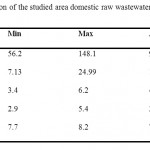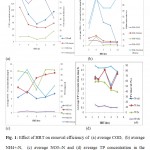Effect of Hydraulic Retention Time and Recycle Ratio on Anoxic/Oxic Bioreactor and Artificial Wetland Performance for Domestic Wastewater Treatment
John Leju Celestino Ladu1,2 * , Meiling Zheng1 , Paul Ladu Demetry3 and Xiwu Lu1
1
Department of Environmental Science and Engineering,
School of Energy and Environment,
Southeast University,
Nanjing,
210096
P. R.
China
2
Department of Environmental Studies,
College of Natural Resources and Environmental Studies,
University of Juba,
South Sudan
3
Ministry of Environment and Sustainable Development,
Republic of South Sudan
DOI: http://dx.doi.org/10.12944/CWE.8.2.01
In this study, the effect of Hydraulic retention time (HRT) and recycle ratios on anoxic/oxic Bioreactor and Artificial wetland Performance for domestic wastewater treatment were experimented. Chemical Oxygen demand (COD), Ammonium nitrogen (NH4+-N), Nitrate nitrogen (NO3--N) and Total phosphorus (TP) removal were examined. The temperature was maintained at 20 to 24 and pH ranges was 7.6 – 8.1. The result revealed average COD removal efficiencies of 47, 68, 74, 83 and 85% at HRT of 1.5, 4, 2, 3 and 5hrs, and recycle ratios of 3, 2, and 1. Average removal of NH4+-N was 78, 85, 88 and 89 % at HRT of 5, 3, 4 and 1.5hrs and recycle ratios of 1, 2, and 3. Average removal of NO3--N was 92, 94, 95 and 97% at HRT of 2, 1.5, 3, 5 and 4hrs and recycle ratios of 3, 1 and 2. The average removal of TP was 78, 85, 88 and 89% at HRT of 5, 3, 2 and 1hr with recycle ratios of 1, 2, and 3 respectively. The system removed up to 74.1, 85%, 94.4% and 85% of the COD, NH4+-N, NO3--N and TP at different HRT, recycle ratios and with proper pH control using external source of alkalinity. The optimum recycle ratio was found to be 3. The result revealed high removal performance at increasing HRT and recycle ratios.
Copy the following to cite this article:
LADU J. L. C, LU X, ZHENG M, DEMETRY P. L, LU X. Effect of Hydraulic Retention Time and Recycle Ratio on Anoxic/Oxic Bioreactor and Artificial Wetland Performance for Domestic Wastewater Treatment. Curr World Environ 2013;8(2) DOI:http://dx.doi.org/10.12944/CWE.8.2.01
Copy the following to cite this URL:
LADU J. L. C, LU X, ZHENG M, DEMETRY P. L, LU X. Effect of Hydraulic Retention Time and Recycle Ratio on Anoxic/Oxic Bioreactor and Artificial Wetland Performance for Domestic Wastewater Treatment. Curr World Environ 2013;8(2). Available from: http://www.cwejournal.org?p=416/
Download article (pdf)
Citation Manager
Publish History
Select type of program for download
| Endnote EndNote format (Mac & Win) | |
| Reference Manager Ris format (Win only) | |
| Procite Ris format (Win only) | |
| Medlars Format | |
| RefWorks Format RefWorks format (Mac & Win) | |
| BibTex Format BibTex format (Mac & Win) |
Article Publishing History
| Received: | 2013-04-06 |
|---|---|
| Accepted: | 2013-05-14 |
China is experiencing rapid urban growth. Mounting population, industrialization, urbanization, and changing life style are resulting in the random generation and disposal of wastewater which in turns pollute the water environment. Nowadays, domestic wastewater has been widely studied by many researchers using different treatment processes, either by application of high-rate aerobic systems,1, 2, 3 or by application of low-rate systems3 and vertical flow constructed wetlands.4 Constructed wetlands are considered as an appropriate technology for treating domestic sewage in the rural areas of China with climatic, population, and socioeconomic considerations.5 To meet the standard effluent quality discharge of China, integrated A/O system and constructed wetlands is considered to be the best option.
Material and Methods
Experimental set-up
The experimental system is made up of an influent tank, pumps (model BT100), the integrated A/O system and artifical wetlands, an air compressor for aeration, and automatic aeration mixers to provide aeration in the oxic zones. The anoxic reactor has a total effective volume of 60 L and the oxic reactor has three segments with a total capacity of 27L. The reactor was connected in series with an internal diameter of 0.2m and a height of 2m for the anoxic columns. The oxic column has width size of 30cm and effective depth of 10cm, 20 and 30cm for first, second and third oxic segment. The height difference between each adjacent unit of Oxic is 0.5m. The domestic sewage drops to some porous baffles after it was pumped to a certain height. Both of the reactor’s columns (A/O) were filled with a non-woven fabric filter materials. The artificial wetland has a plot area of 1.2m2 and bottom slope of 0.003%. Each chamber was composed of three different layers of matrix particles of different sizes: the 200mm layer of coarse gravel (20 to 40mm in diameter) and the 250 mm layer of grit gravel in the bottom, in the upper is a 100mm layer of fine sand (0.5-1.2 mm in diameter). The artificial wetland was planted with Chinese celery (Oenanthe javanica). Temperature was maintained in the range of 20 to 26.
Wastewater for the experiment and Analytical Procedures
Raw wastewater from a campus main manhole was pumped into a storing tank for sedimentation, and then fed into the reactor. The A/O reactor was inoculated with sludge obtained from Wuxi municipal sewage treatment plant. The raw domestic wastewater composition is shown in Table 1. The influent and effluent samples were collected in separate bottles after every two days and stored in refrigerator at 4oC before experimental tests. The internal recycle ratio, R, can be defined as the ratio of returned flow rate (Qr) to that of the main influent flow rate (Q0). All the analyses were carried out in accordance to6 The influent and the effluent COD, NH4+-N, NO3--N and TP were measured according to.7
 |
Table 1: Composition of the studied area domestic raw wastewater Click here to View table |
Result and Discussion
Organic Material Removal (COD)
The average concentrations of COD in the influent and effluent during the experimental operations were 91.1mg/L and 17.4mg/L respectively. It can be noted that, COD removal efficiency increases with increase in HRT (fig. 1 (a). The overall removal efficiency of COD was 70.4%. This result obtained is quite similar to the study conducted by.8, 9 In this study, the average removal of COD was 42, 68, 74, 83, and 85% with effluent concentration of 34, 17.5, 11.7, 7.7 and 15.9mg/l under HRT of 1.5, 4, 2, 3 and 5hrs, recycle ratios of 3, 2 and 1 respectively.
NH4+-N and NO3--N Removal
The overall removal of NH4 +-N by the reactor was 85% almost similar to that obtained by.8 The average concentrations of NH4 +-N in the influent, anoxic oxic and artificial wetland during the experimental operations were 11, 2.4, 1.1 and 1.5mg/L respectively. The average removal of NH4 +-N was 78, 85, 85, 88 and 89 % with effluent concentration of 1.9, 1.2, 1.3, 2.1 and 1.2mg/l operated with HRT of 5, 3, 2, 4 and 1hr respectively fig. 1(b). According to literatures and a study by,10 the optimum pH condition for nitrifying bacteria is 7.5 to 8.6. For this study, the value of pH was maintained between the ranges of 7.6 to 8.1 indicating satisfactory condition of the reactor. In order for simultaneous nitrification and denitrification to take place in the anoxic reactor, the reactor was intermittently aerated. The average DO concentration in the reactor was in range of 2.2 to 3.1 mg O2/l, respectively. During the operation, there is high concentration NO3--N in the effluent of the nitrification reactor (oxic). The overall removal of NO3--N by the system was 94%. The average removal of NO3--N was 92, 94, 94 and 97% with effluent concentration of 0.3, 0.2and 0.5mg/l operated with HRT of 2, 3, 5and 4hrs and recycle ratios of 2, 3, and 1 respectively fig. 1 (c). Increase in recycle ratio (R) enhances the denitrification efficiency of A/O but according to,11 high increase of recycle ratio also inhibits denitrification.
Total Phosphorus Removal
The removal of TP was quite stable despite the concentration of TP in the influent was ranging between 2.9mg/l to 4.5mg/l. The effluent TP was mostly below 0.5 mg/. Most of the TP removal was accomplished in artificial wetland. The overall removal efficiency was 83%. The average removal of TP was 78, 85, 88 and 89% with influent and effluent concentration of 4.3, 3.5, 4.5, 2.9, 3.8mg/l and 0.5, 0.6, 0.7, 0.5 and 0.8mg/l operated with HRT of 5, 3, 2, and 1hr with recycle ratios of 3, 2 and 1 respectively fig. 1(d). Although temperature fluctuates and reed in the artificial wetland withered steadily during the winter season, TP removal wasn’t affected.
 |
Figure 1: Effect of HRT on removal efficiency of (a) average COD, (b) average NH4+-N, (c) average NO3--N and (d) average TP concentration in the influent, anoxic, oxic reactors and artificial wetland Click here to View figure |
Conclusion
This study used A/O and constructed wetland for treatment of campus domestic wastewater at different operating condition. According to the result obtained during the whole experimental operation, the A/O reactor and constructed wetland emerge to be well suited to the treatment of this kind of low strength campus domestic wastewater. Since heterotroph uses organic substrates as a source of carbon, heterotrophic denitrification is responsible for COD degradation. In the constructed wetland, most of the TP removal was accomplished by medium interception, microbial transformation and plant adsorption. The result obtained revealed that, the A/O reactor and constructed wetland is suitable and efficient in organic matter and nutrient removal
Acknowledgment
This research has been supported by the National Natural Science Foundation of China (51078074) and the Key Project of Chinese Ministry of Education (308010).
References
- Nolde, E., (1999). Greywater reuse systems for toilet flushing in multi-storey building-over ten years experience in Berlin. Urban Water 1, 275–284.
- Jefferson, B., Laine, A.L., Judd, S.J., Stephenson, T., (2000). Membrane bioreactors and their role in wastewater reuse. Water Sci. Tech. 41 (1), 197–204.
- Jefferson, B., Laine, A., Parsons, S., Stephenson, T., Judd, S., (1999). Technologies for domestic wastewater recycling. Urban Water 1, 285–292.
- Otterpohl, R., Braun, U., Oldenburg, M., (2003). Innovative technologies for decentralised water, wastewater and biowaste management in urban and peri-urban areas. Water Sci. Technol. 48 (11/12), 23–32.
- Min Tao, et al., (2010). How Artificial Aeration Improved Sewage Treatment of an Integrated Vertical-Flow Constructed Wetland. Polish J. of Environ. Stud. Vol. 19, No. 1 (2010), 183-191
- CJT 221. 2005. Determination method for municipal sludge in wastewater treatment plant[S].
- APHA (1999).Standard Methods for the Examination of Water and Wastewater, 19th ed. WashingtonDC, Amer Public Health Assoc, 1995.
- Gurung, A., Kang, W.Chang and Oh Sang-Eun (2011). Removal of nitrogen from anaerobically digested swine wastewater using an anoxic/oxic (A/O) process complemented with a sulfur-packed biofilter African Journal of Biotechnology Vol. 10(48), pp. 9831-9838, 29 August, 2011
- Chul Hee Won and Jay Myoung Rim, Anaerobic/oxic Treatment of Slurry-type Swine Waste, Environ. Eng. Res. Vol. 13, No. 4, pp. 203~209, 2008
- Yoo H, Ahn KH, Lee HJ, Lee KH, Kwak YJ, Song KG (1999). Nitrogen removal from synthetic wastewater by simultaneous nitrification and denitrification (SND) via nitrite in an intermittently aerated reactor. Water Res. 33: 145-154.
- Tan TW, Ng HY (2008). Influence of mixed liquor recycle ratio and dissolved oxygen on performance of pre-denitrification submerged membrane bioreactors. Water Res. 42: 1122-1132.






